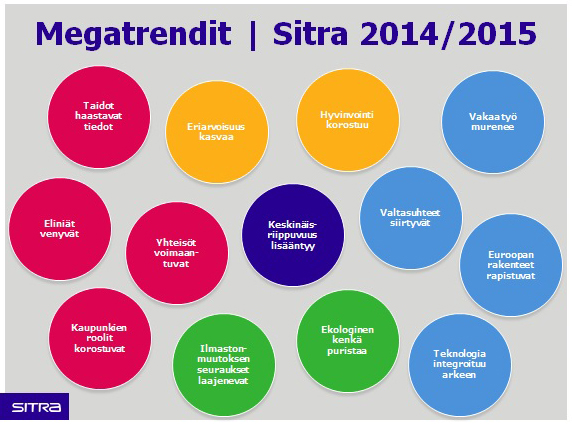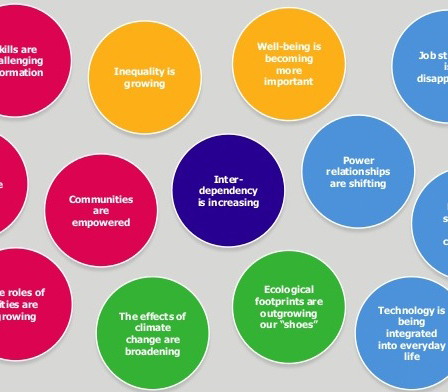The labour market is rapidly changing and the economic situation will not necessarily be conducive to job creation in the future. Amid all this turmoil, Finland also has much to gain – but how much comfort is that to the average person about to lose his or her job due to automation and digitisation?
We are losing average wage-level jobs. This is down to the usual suspects: information technology, automation and intensifying global competition. The phenomenon has spread to all corners of the globe, with nearly all Western countries facing it at some point. It is no news that the repercussions of these trends can be seen very clearly in Finland’s job market: The share of average-wage employees has been reducing since the 1990s and employment relationships have taken on new forms.
Routine work is being replaced in advanced societies. However, whether we look at it from the macroeconomic or consumer perspective, this development has many positive aspects: productivity of work will increase and most of us will no longer need a middle man between ourselves and basic banking services, for example.
Or airport check-ins. Or retail purchases. Knowledge workers have become their own secretaries.
But with every technological advance and the further penetration of automation into new areas of society, we are being forced to reconsider the irreplaceable nature of work. Humans are being replaced by machines at a faster rate, even in knowledge work.
And although new technology is creating new work and opportunities, the pace may slow, with the beneficiaries not necessarily being the same people whose jobs become obsolete. Upon what can we build a positive vision of work in the future?
Entrepreneurship can be based on pull, chance or necessity
As permanent, paid work becomes less available, people will have to broaden their criteria when seeking new employment opportunities. New research data was recently published regarding the self-employment situation in Finland; an area that has remained off the radar on earlier occasions. According to a report by Statistics Finland, people become self-employed without employees through three paths: the desire to become an entrepreneur, seizing an opportunity or by necessity. This last group, necessity entrepreneurs, was the topic of research conducted for a doctoral thesis by Jenni Kantola, completed in May 2014.
But perhaps it really is not the case that workers will have to broaden their expectations. According to Statistics Finland, self-employed people have a stronger sense of drive in the work they do compared to wage and salary earners, and six out of ten evaluate their financial situation as fully or somewhat stable and secure.
But there are two sides to this coin: four out of ten feel burdened by the uncertainty of their financial situation. Stress caused by an uncertain financial situation is particularly notable among those working in the cultural sector and craft workers, and men are more likely than women to feel that their financial situation is secure.
“Self-employment is becoming the solution – or an unforeseen opportunity – for an increasing number of people who lose their jobs,” says Jenni Kantola. “Necessity entrepreneurship is not restricted to one line of business, it affects us all. We need to acknowledge and accept this, because there are ways of preparing people for life as an entrepreneur.”
As an example, Kantola mentions universities where, aside from a few incubators, entrepreneurship education has a very low profile. While a considerable percentage of students choose to become consultant entrepreneurs, the underlying reason is often their disappointment with working life. Such an experience of disappointment often reflects on the entire career and expectations of entrepreneurs.
“Attitudes need to change in order to make the fall-back the number one option. Self-employment is not about losing the fight against the system, quite the opposite: entrepreneurs are bold trailblazers,” Kantola is keen to emphasise.
Not everyone is a natural-born entrepreneur, and entrepreneurship is not the same in all lines of business. Because self-employment is a working-life phenomenon that is expected to keep growing, Kantola believes that public discussion and means of support need to take better account of the differences between individuals and lines of business. Despite the media prominence of creative sector start-ups, this not even close to being the whole story.
“The dichotomy between paid work and entrepreneurship should be eliminated and flexibility increased, for example by creating more collective forms of co-entrepreneurship. This could prove an enticing alternative to people whose formative years have prepared them solely for conventional, paid work.”
Social actors need to take a leap into the future
The need to eliminate the distinction between paid work and entrepreneurship is a question of our social structures as much as our attitudes. There is no longer a direct path from study into working life and then retirement. However, our entire system for organising employment and livelihoods is built on the traditional idea of work – permanent and full-time paid work.
Nothing new there either. There has been plenty of talk about new types of work, but no major reforms have been implemented. Does this mean that more people will begin to question labour market rules and traditional institutions, such as trade unions?
Elina Moisio, an expert from Akava (the trade union confederation of affiliates for highly educated people) admits that the entire Finnish concept of the wage earner needs to be updated. “To put it simply: with an increasing number of working people who cannot be fully characterised as self-employed or wage earners, and due to potentially rapid changes in circumstances, small business entrepreneurs should be granted the same unemployment benefits as wage and salary earners.”
Does this mean that our current system, which only enables people to be primarily classified as one thing at a time, should be revamped to ensure that there are no breaks in social security when circumstances change? ”Yes, and this is a task for social organisations.”
Working life is changing, both inside and out. Internal changes are most visible in the everyday lives of the knowledge workers represented by Akava. The two key aspects are: an ability to learn – people need to continuously update their expertise in order to keep up with the changing requirements of working life; and life management skills – greater freedom to organise one’s own tasks leads to the blurring of the line between work and leisure time.
All in all, it is easier to make predictions about factors likely to increase the uncertainty of working life in the future, rather than those that might increase people’s sense of security. The trends driving change seem to be aimed at a single goal: shifting responsibility from systems to individuals. According to Moisio, Finland has much to gain from the transformation of the labour market.
“We tend to take our work very personally. Many opportunities for creating new work exist, but can you imagine taking the leap when it is YOUR job that is on the line? Understanding this concern, alongside being aware of when to take that leap into the future, is of the essence,” says Moisio.
She concludes: “The uncertainty felt by many stems from our having created our structures based on the ethos of long-term careers as wage earners. If the structures do not support your lifestyle and the social security system has been built for a life situation that is different to yours, you will be left feeling like an exception to the rule.”
Read more:
University of Vaasa: Doctoral thesis: Narrating coping experiences of necessity entrepreneurs
Statistics Finland: Self-employed without employees in Finland 2013
PC Mag UK: 20 Jobs Likely to Be Replaced by Robots (and 20 That Are Safe)
Wall Street Journal: Daddy, What Was a Truck Driver?
ISSUU – Future Tense 2014 by Futures Group
Foreign Affairs: A New World Order: Labor, Capital and Ideas in the Power Law Economy


Recommended